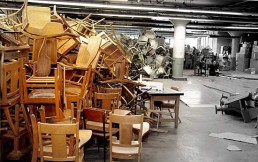This might sound like a strange subject to write about, but it’s a question I get asked quite often:
“Do I have to move the furniture?”
Let me answer it this way. One thing I’ve noticed is that some people seem to think I show up and suddenly become Lord and Master of the house.
Now, I might bring in enough equipment to make it look like I’m taking over the place—but the truth is, I’m a guest in your home. You have every right to tell me where to go, even before the job is done. It’s your space, and I work with your preferences.
So, when it comes to moving furniture, my answer is simple:
“You move what you want to move. I’ll work around whatever you choose to leave in place.”
To give you an idea of what usually stays put: most people don’t move their TV. Modern televisions are massive, heavy, and often connected to a dozen other devices with what feels like 87 different cords. Taking it apart might take hours—and putting it back together could take the rest of the month! Most people take one look and decide it’s not worth the hassle. Fair enough.
Wall units fall into the same category. When we moved into our current house, it came with a “free” wall unit—not because the previous owners were generous, but because it was too big to move. If professional removalists couldn’t shift it, I’m certainly not going to budge it during a carpet clean.
Large dining tables? Same story. After all the chairs are removed, I clean and treat the carpet under the table as best as possible, working around the table legs and base.
Couches and recliners are a bit more flexible. They can usually be pushed to one side of the room while I clean, and then returned. That said, if a piece of furniture hasn’t been moved since the last clean—and nothing has spilled or settled beneath it—do you really need to move it?
There’s only one thing I always ask when furniture is being shifted:
“Does it have wooden feet?”
Wooden feet can stain damp carpet, so I take extra care around them. But even with the utmost caution, accidents can happen and possibly the best idea is to not move them at all, so the carpet under the feet stay dry.
If you have fragile or valuable items—especially those sitting on or near furniture—it’s always a smart move to relocate them before I arrive. A few minutes of preparation can save you from hours of stress if something accidentally gets bumped or broken.
Yes, I have insurance—but as the saying goes, “Prevention is better than cure.”
I hope this clears things up and helps you feel more prepared next time I visit your home!

